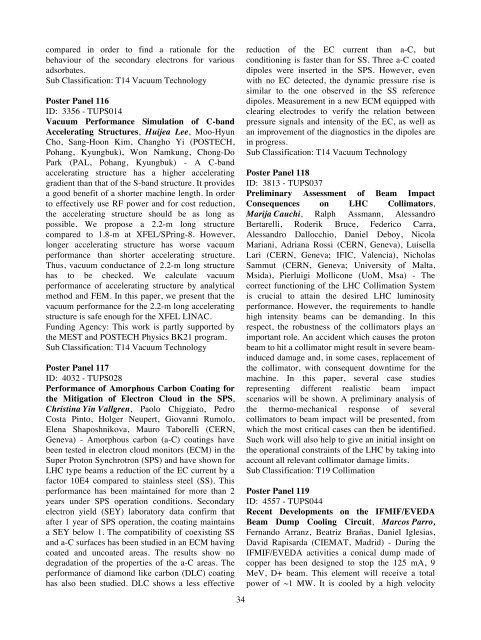Abstracts Brochure - 2nd International Particle Accelerator Conference
Abstracts Brochure - 2nd International Particle Accelerator Conference
Abstracts Brochure - 2nd International Particle Accelerator Conference
Create successful ePaper yourself
Turn your PDF publications into a flip-book with our unique Google optimized e-Paper software.
compared in order to find a rationale for the<br />
behaviour of the secondary electrons for various<br />
adsorbates.<br />
Sub Classification: T14 Vacuum Technology<br />
Poster Panel 116<br />
ID: 3356 - TUPS014<br />
Vacuum Performance Simulation of C-band<br />
Accelerating Structures, Huijea Lee, Moo-Hyun<br />
Cho, Sang-Hoon Kim, Changho Yi (POSTECH,<br />
Pohang, Kyungbuk), Won Namkung, Chong-Do<br />
Park (PAL, Pohang, Kyungbuk) - A C-band<br />
accelerating structure has a higher accelerating<br />
gradient than that of the S-band structure. It provides<br />
a good benefit of a shorter machine length. In order<br />
to effectively use RF power and for cost reduction,<br />
the accelerating structure should be as long as<br />
possible. We propose a 2.2-m long structure<br />
compared to 1.8-m at XFEL/SPring-8. However,<br />
longer accelerating structure has worse vacuum<br />
performance than shorter accelerating structure.<br />
Thus, vacuum conductance of 2.2-m long structure<br />
has to be checked. We calculate vacuum<br />
performance of accelerating structure by analytical<br />
method and FEM. In this paper, we present that the<br />
vacuum performance for the 2.2-m long accelerating<br />
structure is safe enough for the XFEL LINAC.<br />
Funding Agency: This work is partly supported by<br />
the MEST and POSTECH Physics BK21 program.<br />
Sub Classification: T14 Vacuum Technology<br />
Poster Panel 117<br />
ID: 4032 - TUPS028<br />
Performance of Amorphous Carbon Coating for<br />
the Mitigation of Electron Cloud in the SPS,<br />
Christina Yin Vallgren, Paolo Chiggiato, Pedro<br />
Costa Pinto, Holger Neupert, Giovanni Rumolo,<br />
Elena Shaposhnikova, Mauro Taborelli (CERN,<br />
Geneva) - Amorphous carbon (a-C) coatings have<br />
been tested in electron cloud monitors (ECM) in the<br />
Super Proton Synchrotron (SPS) and have shown for<br />
LHC type beams a reduction of the EC current by a<br />
factor 10E4 compared to stainless steel (SS). This<br />
performance has been maintained for more than 2<br />
years under SPS operation conditions. Secondary<br />
electron yield (SEY) laboratory data confirm that<br />
after 1 year of SPS operation, the coating maintains<br />
a SEY below 1. The compatibility of coexisting SS<br />
and a-C surfaces has been studied in an ECM having<br />
coated and uncoated areas. The results show no<br />
degradation of the properties of the a-C areas. The<br />
performance of diamond like carbon (DLC) coating<br />
has also been studied. DLC shows a less effective<br />
�<br />
34<br />
reduction of the EC current than a-C, but<br />
conditioning is faster than for SS. Three a-C coated<br />
dipoles were inserted in the SPS. However, even<br />
with no EC detected, the dynamic pressure rise is<br />
similar to the one observed in the SS reference<br />
dipoles. Measurement in a new ECM equipped with<br />
clearing electrodes to verify the relation between<br />
pressure signals and intensity of the EC, as well as<br />
an improvement of the diagnostics in the dipoles are<br />
in progress.<br />
Sub Classification: T14 Vacuum Technology<br />
Poster Panel 118<br />
ID: 3813 - TUPS037<br />
Preliminary Assessment of Beam Impact<br />
Consequences on LHC Collimators,<br />
Marija Cauchi, Ralph Assmann, Alessandro<br />
Bertarelli, Roderik Bruce, Federico Carra,<br />
Alessandro Dallocchio, Daniel Deboy, Nicola<br />
Mariani, Adriana Rossi (CERN, Geneva), Luisella<br />
Lari (CERN, Geneva; IFIC, Valencia), Nicholas<br />
Sammut (CERN, Geneva; University of Malta,<br />
Msida), Pierluigi Mollicone (UoM, Msa) - The<br />
correct functioning of the LHC Collimation System<br />
is crucial to attain the desired LHC luminosity<br />
performance. However, the requirements to handle<br />
high intensity beams can be demanding. In this<br />
respect, the robustness of the collimators plays an<br />
important role. An accident which causes the proton<br />
beam to hit a collimator might result in severe beaminduced<br />
damage and, in some cases, replacement of<br />
the collimator, with consequent downtime for the<br />
machine. In this paper, several case studies<br />
representing different realistic beam impact<br />
scenarios will be shown. A preliminary analysis of<br />
the thermo-mechanical response of several<br />
collimators to beam impact will be presented, from<br />
which the most critical cases can then be identified.<br />
Such work will also help to give an initial insight on<br />
the operational constraints of the LHC by taking into<br />
account all relevant collimator damage limits.<br />
Sub Classification: T19 Collimation<br />
Poster Panel 119<br />
ID: 4557 - TUPS044<br />
Recent Developments on the IFMIF/EVEDA<br />
Beam Dump Cooling Circuit, Marcos Parro,<br />
Fernando Arranz, Beatriz Brañas, Daniel Iglesias,<br />
David Rapisarda (CIEMAT, Madrid) - During the<br />
IFMIF/EVEDA activities a conical dump made of<br />
copper has been designed to stop the 125 mA, 9<br />
MeV, D+ beam. This element will receive a total<br />
power of ~1 MW. It is cooled by a high velocity


